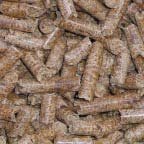What Goes Into Biomass Wood Pellets?
You might ask "What is Biomass?". It's the vegetable residue of agricultural operations such as growing crops, milling timber, farming cattle and clearing ground.
Residential, or premium grade wood pellets contain nothing else but wood. No glues are needed in the production of pellets.
When the pulped wood or sawdust is forced into the wood pellet die under pressure and heat, natural binding material already present, (lignin), allows the pellet to hold its shape. A premium grade pellet contains very little potential ash. 1%.
Standard, or commercial grade pellets contain more impurities, 3% potential ash. This is because paper, bark, and other flammable additives are included.
It's important to use the correct grade of pellet for your stove, fire or furnace. Too great a build up of ash can cause the fire to go out, or overload the ash can.
Alternative pellet stove fuels are possible (see link at bottom of page) if you would prefer not to be dependent on only wood pellets, or only corn. These fuels have a high ash content and are best burned in a multi fuel pellet stove.
To make pellets, the raw material must first be cleaned to remove impurities. The clean biomass is then ground in a hammer mill or chipped to a uniform size, which must be less than the thickness of the pellet that will be produced.While the lignin content in wood is generally enough to bind pellets, other forms of biomass require special conditioning to strengthen them. Sometimes binders such as starch, sugars, paraffin oils, or lignin must be added to make the biomass malleable.
Some pellet stoves are also capable of burning corn either by itself or mixed with wood pellets. When buying corn for burning, it is important that it's not been treated in any way or the already high ash content will be increased and the emissions could be unpleasant.

What Are The Advantages of Pellet Stove Fuel?
Pellets are clean, easy to handle, and don't have bugs crawling out of them. Anyone who's burned logs will appreciate this. Usually packaged in 40lb. bags, they are easy to stack and don't take up much space. A ton of pellets will stack in a 4' by 4' space, four feet high. The stove hopper only needs loading daily. Even less often for furnaces.
The standardisation of pellet size and moisture content means that the burn can be efficiently regulated and the air input accurately controlled. Pellets have a usual moisture level of less than ten per cent. (Logs 20 - 60%).
This gives high heat output, clean burning and low emissions. The thermal value of wood pellets is 5Kwh per kilo, (or 8 - 9 thousand btu. per pound). Two kilos of pellet are equivalent to a litre of fuel oil or a cubic metre of natural gas.
Carbon Neutral Biomass Heating
Biomass is the term given to grown material as opposed to fossil fuel. The carbon absorbed in growth is balanced by carbon emitted on burning, which makes the use of wood pellets neutral. Wood pellet plant is often, but not always, powered by burning wood pellets.
This energy supply is sustainable because the raw materials are renewable.Trees are not felled just to make pellets. The raw material is already a waste product from saw mills and other users of timber. Converting sawdust to pellets reduces the amount of waste going to landfill.
Another point is that pellets are usually locally made. It would not be economic to transport vast amounts of sawdust across the country, and then bring the pellets back, so it's the local economy that gains from this low carbon footprint industry.
Where Can I Buy Wood Pellets?
It's well worth checking where you can buy fuel in your area. First stop would be your local pellet stove dealer. If they can't source a supply, they won't last long. Another good reason to contact a local stove dealer is to find out if they stock parts, and for which makes and models so if you eventually buy online, you'll know which stoves will be supported.
If you want to find stockists online in North America, go to the Pellet Fuels Institute or in Europe, go to the European Pellet Centre
Pages Related to Biomass





